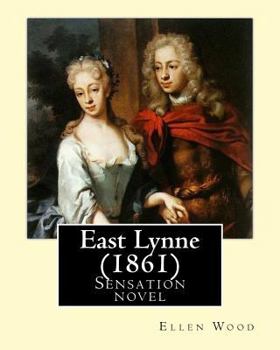East Lynne (1861). By: Ellen Wood: Sensation novel
Select Format
Select Condition 
Book Overview
East Lynne is an English sensation novel of 1861 by Ellen Wood. A Victorian bestseller, it is remembered chiefly for its elaborate and implausible plot, centring on infidelity and double identities. There have been numerous stage and film adaptations. The much-"quoted" line "Gone And never called me mother " (variant: "Dead Dead And never called me mother ") does not appear in the book; both variants come from later stage adaptations. The book was originally serialised in The New Monthly Magazine between January 1860 and September 1861, being issued as a three-volume novel on 19 September 1861. Plot summary: Lady Isabel Carlyle, a beautiful and refined young woman, leaves her hard-working lawyer-husband, Carlyle, and her infant children to elope with an aristocratic suitor, Francis Levison, after wrongfully suspecting and becoming jealous of her husband's friendship with Barbara Hare. However once abroad with Levison she realises he has no intention of marrying her, despite her having borne their illegitimate child. He deserts her, Lady Isabel is disfigured in a train accident and the child is killed. Following this Isabel is able to take the position of governess in the household of her former husband and his new wife allowing her to be close to her children but which also becomes a source of great misery. The pressure of keeping up a fa ade and being constantly reminded that her husband has moved on eventually physically weakens her. On her deathbed she tells all to Carlyle who forgives her. Ellen Wood (n e Price; 17 January 1814 - 10 February 1887), was an English novelist, better known in that respect as Mrs. Henry Wood. She is remembered most for her 1861 novel East Lynne, but many of her books became international bestsellers and widely known in the United States. She surpassed the fame of Charles Dickens in Australia. Life: Ellen Price was born in Worcester in 1814. In 1836 she married Henry Wood, who worked in the banking and shipping trade in Dauphin in the South of France, where they lived for 20 years. On the failure of Wood's business, the family (including four children) returned to England and settled in Upper Norwood near London, where Ellen Wood turned to writing. This supported the family (Henry Wood died in 1866). She wrote over 30 novels, many of which (especially East Lynne) enjoyed remarkable popularity. Among the best known are Danesbury House, Oswald Cray, Mrs. Halliburton's Troubles, The Channings, Lord Oakburn's Daughters and The Shadow of Ashlydyat. Her writing tone would be described as "conservative and Christian,"occasionally expressing religious rhetoric. In 1867, Wood purchased the English magazine Argosy, which had been founded by Alexander Strahan in 1865. She wrote much of the magazine herself, but other contributors included Hesba Stretton, Julia Kavanagh, Christina Rossetti, Sarah Doudney and Rosa Nouchette Carey. Wood continued as its editor until her death in 1887, when her son Charles Wood took over. Wood's works were translated into many languages, including French and Russian.Leo Tolstoy, in a 9 March 1872 letter to his older brother Sergei, noted that he was "reading Mrs. Wood's wonderful novel In the Maze". Wood wrote several works of supernatural fiction, including "The Ghost" (1862) and the often anthologized "Reality or Delusion?" (1868). At her death (caused by bronchitis), her estate was valued at over 36,000, which was then a very considerable sum. She was buried in Highgate Cemetery, London. A monument to her was unveiled in Worcester Cathedral in 1916.
Format:Paperback
Language:English
ISBN:154424018X
ISBN13:9781544240183
Release Date:March 2017
Publisher:Createspace Independent Publishing Platform
Length:354 Pages
Weight:1.55 lbs.
Dimensions:0.7" x 8.0" x 10.0"
Customer Reviews
2 ratings
Condescending snobs need not apply
Published by Thriftbooks.com User , 20 years ago
This book will be enjoyed both by readers who appreciate Ellen Wood's ghost stories and those who devour Sensation fiction. It conveys some of the uncanny atmosphere of the former while remaining as compulsively readable as Lady Audley's Secret. While it is not a Great Work of Literature, let me assure those who genuinely understand and appreciate popular fiction, and are therefore capable of distinguishing between worthwhile examples and trash, that this falls into the former category. I felt that this needed particular emphasis, in order to counteract the hideous possibility that condescending recommendations meted out by self-aggrandizing, obtuse snobs might actually succeed in influencing the perspectives of the impressionable. As for those who have already discovered for themselves that Popular Fiction and Trash are not synonymous; that, furthermore, there is no such thing as Good Trash (after all, if one likes a novel one views as trash, isn't that person bound to renounce either the enjoyment or the disapproval?); and that, most importantly, our Lasting Works of Literature have sprung from a diverse variety of arenas that span the entire range of the culture spectrum; well, maybe they understand why I was peeved enough to pen this little piece.
Disfigured text
Published by Thriftbooks.com User , 27 years ago
Mrs Henry Wood's novel itself doesn't need any recommandation: generations of readers have literally devoured it. My rating however is valid only for the novel in itself.What I should like to comment upon is the edition -- and here my rating is just 2 -- published as a volume of "Everyman's Library"...The text is disfigured by dozens...of misprints -- from a philological point of view, this edition is just useless.The volume is out of print at the moment. This should be welcomed by the editors as an occasion to correct those numberless misprints. If they don't do so, there is only one comment possible on their edition: forget it.







